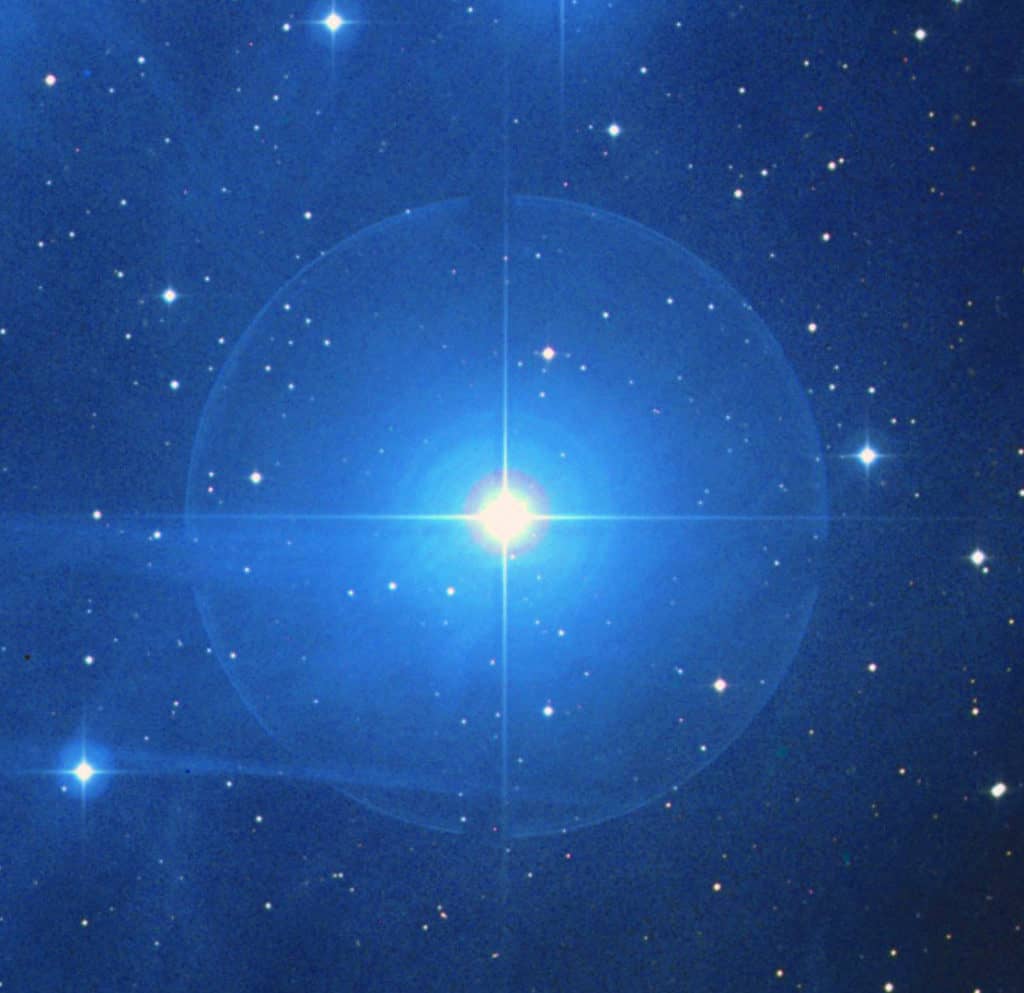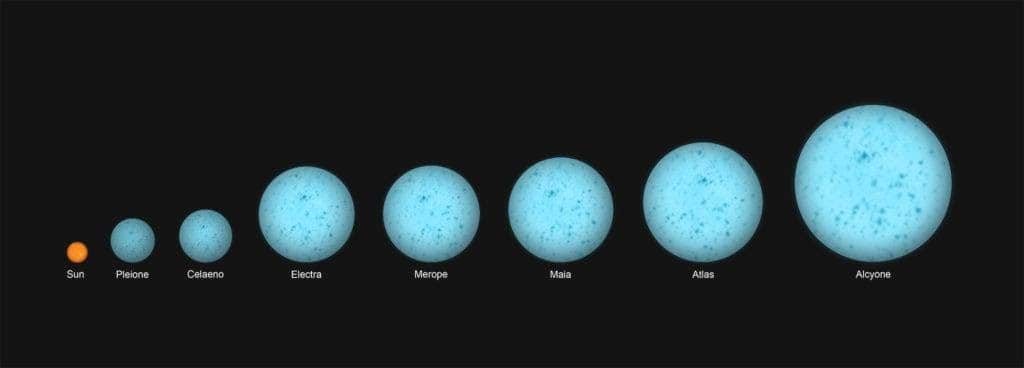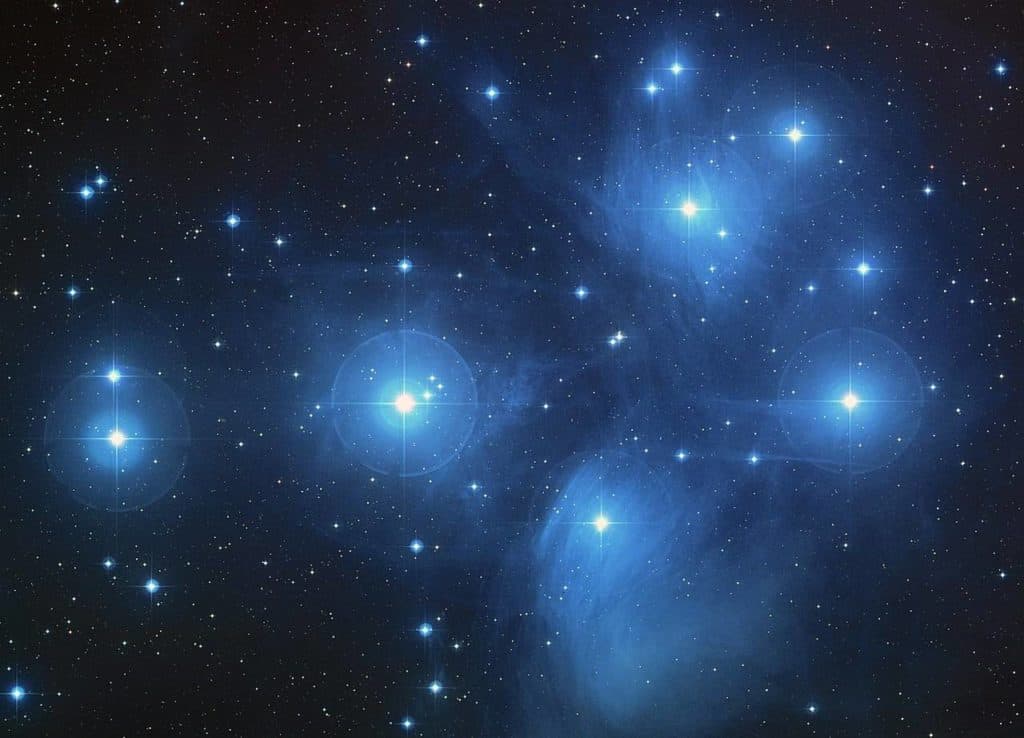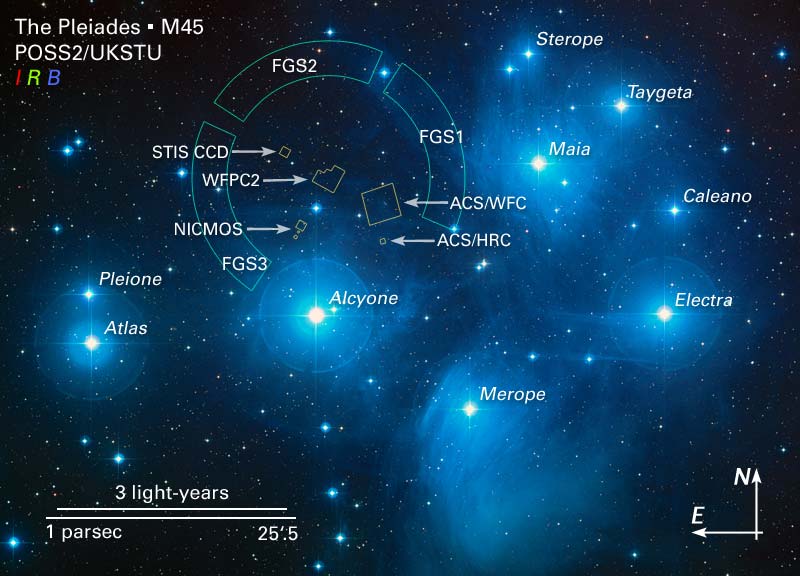Electra, also designated as 17 Tauri, is a blue-white giant star located in the zodiacal constellation of Taurus, the celestial bull. It is a member of the Pleiades open star cluster.
Key Facts & Summary
- Electra is the third brightest star in the Pleiades open cluster, located at around 400 light-years away from the Sun.
- This star has an apparent magnitude of 3.70 and an absolute magnitude of -1.77.
- Electra is a blue-white giant star of spectral type B6IIIe, thus it has prominent emission lines of hydrogen in its spectrum.
- Electra is quite a young star, having an estimated age of only 115 million years, much younger than our Sun.
- Apart from the age gap, Electra has around 6.06 solar radii, and around its mass is still analyzed but it clearly is several times more massive than our Sun.
- Electra produces much more energy than our Sun, being 940 times brighter.
- The surface gravity on Electra has been estimated to be at around 3.4 cgs.
- Average surface temperatures on Electra have been recorded at around 13,484 K.
- Electra is a fast-spinning star, with a rotational velocity at 181 km / 112 mi per second.
- Electra is probably enveloped by a gaseous disk created by radiation-driven mass loss and because of the star’s rapid rotation.
- The radial velocity of Electra has been estimated to be at +10.9 km / +6.7 mi per second.
- The zodiacal constellation of Taurus and the Pleiades open cluster is known to humanity for thousands of years.
- The Pleiades cluster is very bright, but it cannot be seen during May and June since the Sun blocks our view of the cluster in that period.
- The Pleiades open cluster itself is farther away from us than Electra, at 444 light-years.
The star’s name, Electra, comes from Greek mythology. Electra was one of the Pleiades, the seven daughters of the Titan Atlas, and the Oceanid nymph Pleione.

Electra translates to “amber” and “bright” in Greek. In the mythos, Electra was the mother of Iasion and Dardanus, the founder of Troy. Some sources state that she was the lost Pleiad, who disappeared in grief after the destruction of the city in the Trojan War.
The star’s name was approved fairly recently, in 2016, by the IAU.
Formation
Electra, along with its neighboring stars in the Pleiades cluster, formed between 75 and 150 million years ago. This open cluster is among the closest star clusters to Earth.
Some sources give Electra a more exact age, approximately 115 million years. This is very young in comparison to our Sun, which is 4.6 billion years old
All the stars in the Pleiades cluster have a common origin, they formed through a gigantic molecular cloud of dust and gas.
Gravity pulled the swirling gas and dust together and formed the Pleiades cluster. The Pleiades cluster is overall dominated by very hot blue and luminous stars.
Distance, Size, and Mass
Electra is at around 400 ± 10 light-years / 124 ± 4 parsecs away from the Sun. It is a giant star having around 6.06 solar radii or 606% of the Sun’s radius.

Electra’s mass and diameter are still unknown, however, it estimated that it is around 5 times more massive than our Sun, and when taking into consideration Electra’s radius, its diameter should be around 12 times greater than our Sun’s.
Other Characteristics
Electra is a blue-white giant star of spectral type B6IIIe. It has prominent emission lines of hydrogen in its spectrum. The average surface temperatures of Electra have been estimated at around 13,484 K.
This means that Electra is 2.3 times hotter than our Sun. Electra is also 940 times brighter than our Sun. Electra, like most of its neighbors, is a very fast-spinning star.

It has a rotational velocity of at 181 km / 112 mi per second, and possibly more at its equator. Because of this speed, Electra is surrounded by a disk of ejected material around the equator.
Thus it is also classified as a Be star. Its equatorial radius is greater than its polar radius since the poles are flattened (due to the speed) and the equatorial region bulges out because of it.
At the same time, Electra’s surface temperature, gravity, and brightness are higher at its poles. This phenomenon is called gravity darkening, a conditioned also witnessed in the stars Achernar and Vega, in the constellations of Eridanus and Lyra.
Stellar System
The bright nebulosity that surrounds Electra makes it difficult for astronomers to properly analyze its surroundings. However, changes in the star’s radial velocity indicate that Electra may have a companion.
Some sources state that the companion star is 1 AU from Electra, and that the two stars have an orbital period of around 100 days.
Location
Electra is located in the zodiacal constellation of Taurus, the celestial bull. It is the third brightest star of the famous Pleiades open cluster. The Constellation of Taurus is also home to another great open cluster named Hyades.

This constellation is among the largest in the night sky, and also one of the most prominent of the northern constellations occupying an area of 797 square degrees.
The constellation of Taurus, apart from the two mentioned clusters, also has many interesting stars such as Aldebaran, Elnath, and also other fascinating deep-sky objects such as the Crab Nebula, Crystal Ball Nebula, merging galaxies and many more open clusters.
These celestial objects are best observed and studied during January.
Pleiades Member
Electra is the third brightest star/member of the Pleiades open cluster. From October to April, these stars can be observed and studied, however, May and June are not suitable for observation since the cluster is too close to the Sun.
The Pleiades open cluster is among the closest star clusters to Earth, and one of the brightest in our vicinity. Though the cluster is very bright and easy to find, you may also draw an imaginary line from the stars of Orion’s Belt – Alnitak, Alnilam, and Mintaka – past Aldebaran – and find the cluster.

The Pleiades cluster is also known as Messier 45. The majority of the brightest and hottest stars here are of spectral class B, and they formed between 75 and 150 million years ago.
Most of them are far apart from each other, and at around 444 light-years away from us. The most documented and famous stars are all named after the mythological Seven Sisters and their parents from Greek mythology.
The nine stars are Alcyone, Asterope, Atlas, Electra, Celaeno, Maia, Merope, Taygeta, and Pleione. The mythological story depicts the sisters as they caught the eye of Orion, a giant huntsman. Atlas, being condemned for his battles against the gods, was condemned to carry the heavens on his shoulders while Orion, the giant, pursued his daughters.
However, the Greek god Zeus stepped in and transformed the sisters into doves, and then into stars to console their father. Even so, Orion, the giant, is still pursuing the Pleiades sisters across the sky, represented by the Orion constellation.
The Future
Electra will exist for many millions of years however, the Pleides star cluster has been studied closely and many computer simulations predict a grim future.
Most simulations suggest that the cluster will continue to survive for 250 million years before it will start to disperse due to gravitational interactions with its galactic neighborhood.
Did you know?
- The Chinese know Electra as the First Star of Hairy Head – Hairy Head being an asterism formed by the Pleiades stars Asterope, Atlas, Electra, Maia, Merope, Taygeta, and Alcyone. It is one of the seven mansions of the White Tiger.
- U.S. Navy ships USS Electra (1843) and USS Electra ( AK-21/AKA-4) are named after the star.
- The Pleiades star cluster is believed to have been formed from a compact configuration that resembled the Orion Nebula.
- Many cultures throughout the world knew of the Pleiades cluster since ancient times. One of the earliest depictions of the Pleiades cluster and its stars resides in the Nebra sky disk – a Bronze Age artifact dating to 1.6000 BCE, uncovered in Germany.
- Many famous and ancient texts mention the cluster, such as Homer’s Illiad and Odyssey, Hesiod’s Works and Days, the Bible, the ancient Egyptian Calendar of Lucky and Unlucky Days, and the Japanese Kojiki – An Account of Ancient Matters – the 8th-century chronicle of myths, oral traditions, and legends.
- The Pleiades are mentioned in the Kojiki as the Mutsuraboshi – translating to “six stars.” In modern Japan, the cluster is now known as Subaru – the same name used by the famous automobile company that depicts the six brightest stars in their logo.
- One of the first telescopic observations conducted on the Pleiades was during the 1610s. Galileo Galilei observed the bright stars and the cluster and it is noted that he may well be the first to have done so.
Sources:
Image sources:
- https://upload.wikimedia.org/wikipedia/commons/3/30/Electra_%28star%29.jpg
- https://upload.wikimedia.org/wikipedia/commons/thumb/4/4e/Pleiades_large.jpg/1280px-Pleiades_large.jpg
- https://www.star-facts.com/wp-content/uploads/2019/10/Taurus-constellation.jpg?189db0&189db0
- https://upload.wikimedia.org/wikipedia/commons/e/e1/M45map.jpg
